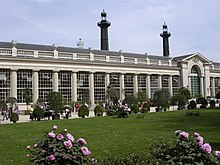



An orangery or orangerie is a room or dedicated building, historically where orange and other fruit trees are protected during the winter, as a large form of greenhouse or conservatory.[1] In the modern day an orangery could refer to either a conservatory or greenhouse built to house fruit trees, or a conservatory or greenhouse meant for another purpose.
The orangery provided a luxurious extension of the normal range and season of woody plants, extending the protection which had long been afforded by the warmth offered from a masonry fruit wall.[2] During the 17th century, fruits like orange, pomegranate, and bananas arrived in huge quantities to European ports. Since these plants were not adapted to the harsh European winters, orangeries were invented to protect and sustain them. The high cost of glass made orangeries a status symbol showing wealth and luxury. Gradually, due to technological advancements, orangeries became more of a classic architectural structure that enhanced the beauty of an estate garden, rather than a room used for wintering plants.[3]
The orangery originated from the Renaissance gardens of Italy, when glass-making technology enabled sufficient expanses of clear glass to be produced. In the north, the Dutch led the way in developing expanses of window glass in orangeries, although the engravings illustrating Dutch manuals showed solid roofs, whether beamed or vaulted, and in providing stove heat rather than open fires.[4] This soon created a situation where orangeries became symbols of status among the wealthy. The glazed roof, which afforded sunlight to plants that were not dormant, was a development of the early 19th century. The orangery at Dyrham Park, Gloucestershire, which had been provided with a slate roof as originally built about 1702,[5] was given a glazed one about a hundred years later, after Humphrey Repton remarked that it was dark; although it was built to shelter oranges, it has always simply been called the "greenhouse" in modern times.[6]
The 1617 Orangerie (now Musée de l'Orangerie) at the Palace of the Louvre inspired imitations that culminated in Europe's largest orangery, the Versailles Orangerie. Designed by Jules Hardouin-Mansart for Louis XIV's 3,000 orange trees at Versailles, its dimensions of 508 by 42 feet (155 by 13 m) were not eclipsed until the development of the modern greenhouse in the 1840s, and were quickly overshadowed by the glass architecture of Joseph Paxton, the designer of the 1851 Crystal Palace. His "great conservatory" at Chatsworth House was an orangery and glass house of monumental proportions.[citation needed]
The orangery, however, was not just a greenhouse but a symbol of prestige and wealth and a garden feature, in the same way as a summerhouse, folly, or "Grecian temple". Owners would conduct their guests there on tours of the garden to admire not only the fruits within but also the architecture outside. Often the orangery would contain fountains, grottos, and an area in which to entertain in inclement weather.[citation needed]
- ^ Gervase Markham, in The Whole Art of Husbandry (London 1631) also recommends protecting other delicate fruiting trees— "Orange, Lemon, Pomegranate, Cynamon, Olive, Almond"— in "some low vaulted gallerie adjoining upon the Garden".
- ^ Billie S. Britz, "Environmental Provisions for Plants in Seventeenth-Century Northern Europe" The Journal of the Society of Architectural Historians 33.2 (May 1974:133–144) p 133.
- ^ "The History of the orangery". Westbury Garden Rooms. 20 March 2014. Retrieved 18 April 2022.
- ^ Britz 1974:134f
- ^ Its columned exterior relates it to the architecture of the house, a feature of orangeries although not of their modern descendants, greenhouses.[citation needed]
- ^ Graham Stuart Thomas, "Orangeries in the National Trust", Quarterly Newslette of the Garden History Society, 1967:25.